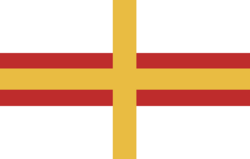Gowcester
Gowcester | |
|---|---|
|
Flag | |
Anthem: '' | |
| 300px | |
| Official languages | Common Standard Ursha |
| Demonym(s) | Cesterton |
Gowcester is a country in western Glaskarn. It shares borders with Seviland to the west, Ohlenschlage and Hunpesh to the north, St Margaret to the east and Krystallum to the south. The southwestern part of the country is on the Elkifjorn Sea.
The area that is now Gowcester was first inhabited by the Askival and Fallkirk tribes in the 8th century. The Fallkirk tribe resisted the efforts of Elkifjor to conquer them and later the Krystallic Empire. The tribe finally was overthrown in 1562 by the United States of Germaeia and Balintnic.
After the fall of the Fallkirk-Kilmorack tribe in 1562, the area was ruled by Saegalia, Balintnic, and the United States of Germaeia. Eventually the USG controlled the entire area of modern day Gowcester until its independence in 1711.
Contents
- 1 History of Gowcester
- 1.1 States of Cesterton and Margaret (USG)
- 1.2 Independence 1711
- 1.3 Krystallic-Ljilislovian trade war
- 1.4 Establishment of the State of Scotianada (1867)
- 1.5 Establishment of the State of St Margaret (1901)
- 1.6 Establishment of the State of Brisbaine (1901)
- 1.7 Establishment of the State of Tudorn (1927)
- 1.8 St Margaret independence (1972-1975)
- 1.9 The Great War (1999-2015)
- 2 Government and Politics
- 3 Geography
- 4 Economy
- 5 Demographics
- 6 Culture
- 7 See Also
History of Gowcester
States of Cesterton and Margaret (USG)
Saegalia controlled the Gowcester region from 1562-1609 when Balintnic and the USG defeated them. In 1609, the region was reorganized as State of Cesterton and the State of St Margaret within the USG. The State of Cesterton was already existed but its territory of control changed vastly.
Within 20 years of the State of Cesterton and the State of St Margaret's reorganization, a major economic depression hit the United States of Germaeia. Cesterton was one of the big three original states of the USG, and therefore had more influence with Chancellor Dene Arran. Arran was of Cesterton descent and served as a magistrate within the State Court of Cesterton before being elected as a representative. Chancellor Arran let Governor ___ do very little to address the economic crisis.
Independence 1711
Krystallic-Ljilislovian trade war
Establishment of the State of Scotianada (1867)
Establishment of the State of St Margaret (1901)
Establishment of the State of Brisbaine (1901)
Establishment of the State of Tudorn (1927)
St Margaret independence (1972-1975)
The Great War (1999-2015)
Government and Politics
Military
International Politics and Agreements
Politics
Migamoralist ideas solidified their place in Gowcester in 1902 with the establishment of the Traditionalist Labour Party. By the 1924 elections, the TLP was the leading minority party in their proportional representation system. The majority Strength and Unity Coalition lost public support amidst their failed interventionist attempt to secure the Beliadist-government in Kathmantu. Their ten-year involvement in the war, and eventual failure, left a bad taste in the mouth of Cestertons in the party. The 1955 snap elections saw the first majority coalition involving the TLP, however, the coalition failed miserably in governing and by 1957, a public referendum ousted the coalition. The Common Sense Coalition took over in 1957 and governed until 1964 when a coalition, led by the TLP called the People's Voice Coalition won a majority. The PVC was continually chaired by the TLP from 1964-1978 with allied parties being added and dropped in subsequent elections. The PVC lost its majority in the 1978 elections with the revival of the public conservative movement.
